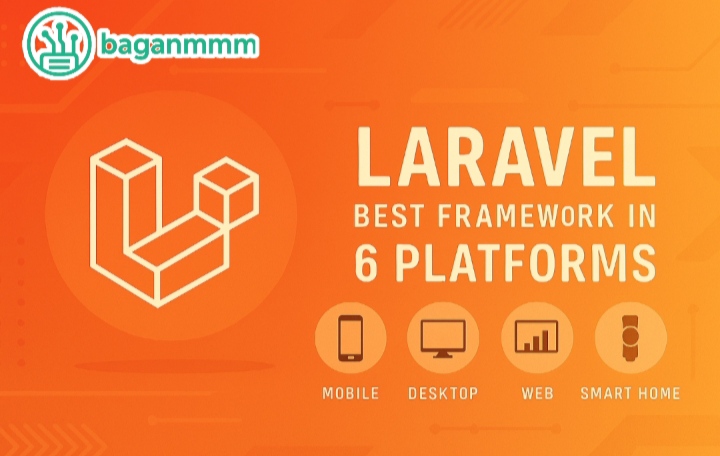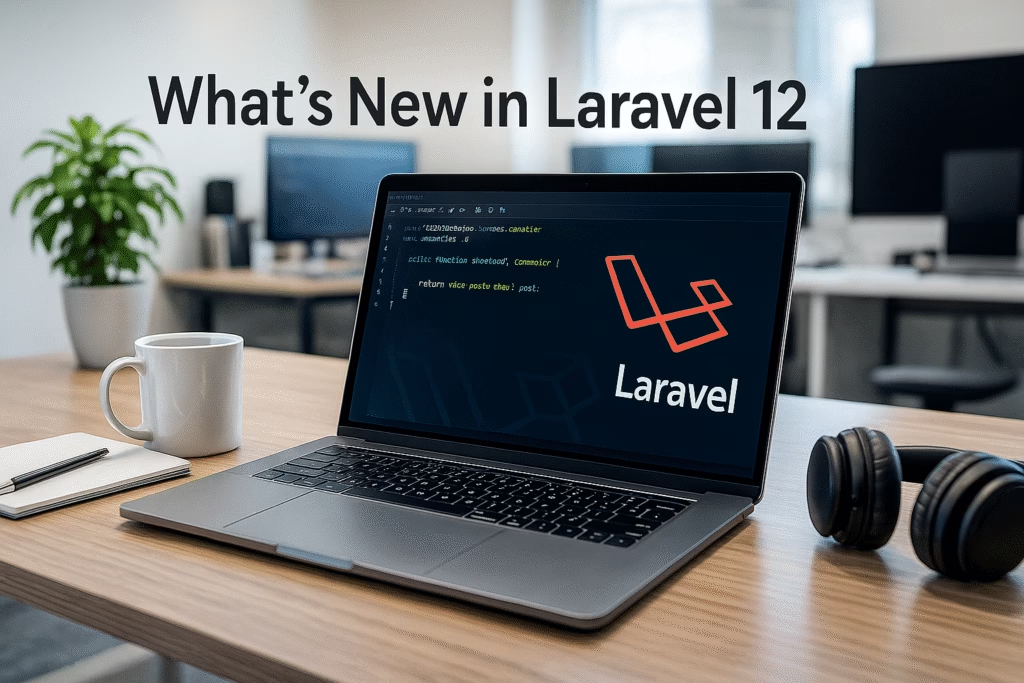When talking about web development, the PHP programming language is indispensable. Why? Because around 75% of websites worldwide are built with PHP. And when discussing PHP, it’s also important to talk about the Laravel framework, which is built on PHP.

Laravel is a free, open‑source framework created with PHP. For every PHP developer, Laravel can be considered one of the best companions. According to statistics, about 2% of websites worldwide use Laravel. Personally, I also use Laravel.
In the latest release, Laravel 12, some new and exciting features have been added. These include AI debugging and a health check information system. Performance and security have also been upgraded, making it suitable for use at the enterprise level. Of course, Laravel was already usable before, but this version makes it even smoother.
One of Laravel’s strengths is that changes are introduced step by step, so developers can upgrade easily without much difficulty. For juniors, it may be a little challenging, but if you understand Laravel’s core framework, you can adapt to these changes quickly.
So, let’s take a look at Laravel’s key points.
What Is Laravel?
Laravel is one of the most popular open‑source web application frameworks built using PHP programming. It provides developers with a convenient and easy‑to‑use syntax, along with many advanced functions and features that are ready to use. Laravel was created in 2011 by Taylor Otwell to make developing web applications with PHP more structured, easier, and faster.
Because of this, Laravel quickly became well‑known and widely used among web developers. Today, Laravel is one of the most popular and most widely used PHP web development frameworks. As its usage has grown, its community has also expanded significantly. By 2025, Laravel has been packaged with new features, updated standards, and enterprise‑level capabilities to ensure smooth usage.
Advantages of Laravel
Syntax
One of Laravel’s main advantages is its standardized and easy‑to‑read syntax. This allows developers to write cleaner and more readable code. Features such as Routing, Middleware, and Eloquent ORM (Object Relational Mapping) support this. These features streamline the development process, reduce errors, and improve code quality. They also make project maintenance, handover, and developer documentation much easier and more efficient.
Routing
Routing is one of Laravel’s core features. It allows developers to define the URLs of a web application and specify the actions to be taken when those URLs are accessed. This provides a more stable project structure and a cleaner architecture. Since projects often contain many routes, being able to manage them all in one place speeds up development time and makes the process more systematic.
Middleware
Another powerful feature of Laravel is Middleware, which allows developers to filter HTTP requests and responses. For example, it can handle user authentication, input verification, and other necessary tasks. Security is one of the most important aspects of any web app, and Laravel’s Middleware provides a structured way to manage it. If developers don’t want to build everything from scratch, Laravel’s built‑in Middleware can easily help, which is a big advantage.
Eloquent ORM
Laravel includes Eloquent ORM, which provides a simple and convenient way to interact with databases. Developers can perform Create, Read, Update, and Delete (CRUD) operations without writing complex SQL queries. In other words, it provides an easy‑to‑use system for working with SQL structures. This is another feature that developers find very satisfying.
Documentation & Community
Another major benefit of Laravel is its comprehensive documentation and active community. Developers have access to a wide range of online resources such as forums, tutorials, and documentation, which help speed up the learning process and provide solutions to common problems.
Other Tools & Services
Laravel also includes additional tools and services such as task scheduling, email sending, and authentication, making it one of the best choices for web application development.
These are the advantages of Laravel. Now, let’s take a look at what new technologies Laravel has added support for in 2025.

What’s New in Laravel 12 (2025 Edition)
Laravel 12 was released in early 2025, bringing major upgrades that make development more convenient and support modern workflows. This is one of Laravel’s most polished transformations and something many developers had been anticipating.
Fresh Starter Kits
Laravel Breeze and Jetstream now support Tailwind CSS v4 and Vite v6, with improved integration for Vue, React, and Livewire. This change allows developers to start a full‑stack project in just a few minutes without any manual setup. Another advantage is that full‑stack web development can now be done seamlessly in one go. While earlier versions also supported this, the new version offers more options and flexibility.
Laravel Reverb (Real-Time Engine)
Laravel now includes its first WebSocket server, enabling developers to directly build chat apps, live dashboards, and notifications. With this addition, developers no longer need third‑party services like Pusher or Socket.io—everything can be built natively within Laravel.
AI-Friendly Architecture
The service container and request lifecycle have been improved to make it easier to integrate AI APIs, chatbots, and LLMs. Developers can now directly connect with OpenAI, Gemini, or custom AI agents. This is a truly significant change, as AI integration has become essential for modern web applications. Laravel’s support here is a timely and impactful upgrade.
Smarter Artisan CLI
Commands like php artisan make:livewire and make:action now include interactive feedback and auto‑suggestions. This speeds up scaffolding and reduces boilerplate code.
Performance Boosts
- Default middleware is now lighter.
- Caching logic is smarter.
- Page loads are faster without requiring extra optimization.
These are improvements best experienced firsthand.
Summary
These are Laravel’s standout changes for 2025. The most notable are AI agent integration, the Real-Time Engine, and enhanced Starter Kits. These features address the essential needs of today’s web development, and Laravel has delivered them right on time.
These are Laravel’s major changes in 2025. Now, let’s take a look at Laravel’s ecosystem for 2025.
Laravel Ecosystem in 2025
In 2025, Laravel is not just a framework it can be considered a complete ecosystem. Why? Because Laravel now includes far more features than a typical framework. Let’s look at some of them:
- Laravel Forge – Server management and deployment
- Laravel Vapor – Serverless hosting on AWS
- Laravel Nova – Admin panel builder
- Laravel Volt – A new frontend tool for building reactive UIs with Livewire
- Laravel Reverb – Real-time communication engine
- Laravel Scout – Full-text search integration
- Laravel Sanctum & Passport – API authentication
With these tools, developers can build a wide variety of projects—such as SaaS platforms, e-commerce stores, and real-time dashboards—entirely within the Laravel ecosystem. This represents a major shift for Laravel, providing stable support that scales from simple websites to e-commerce and even enterprise-level applications. That’s Laravel’s ecosystem in 2025. Next, let’s explore developer insights.
Developer Trends & Insights (2025 Report)
According to research, here’s how web developers are primarily using Laravel:
- 82% of developers use Laravel exclusively for backend development.
- 67% are building products serving fewer than 10,000 users.
- Apps with over 1 million users, 44% are built by teams of fewer than 50 people.
- AI integration and real-time features are the most in-demand skills.
- Eastern Europe, South America, and Asia are the main hotspots for Laravel talent.
This reflects the state of Laravel usage among developers in 2025. These findings don’t represent every region or every developer, so they can’t be taken as absolute results. However, there are many meaningful insights here.
For example, many developers want to use Laravel because of its simple structure, but they avoided it in the past due to weak real-time capabilities and lack of AI integration. Since these needs have now been addressed in 2025, Laravel has become a much more complete solution.
Why Choose Laravel in 2025?
Laravel remains a top choice for developers and businesses because it offers:
- Rapid development with clean syntax
- Built-in tools for authentication, routing, and caching
- Seamless frontend integration
- Real-time and AI-ready architecture
- Massive community and learning resources
- Long-term stability and active updates
Whether you’re building a blog, a SaaS platform, or a full-stack mobile app, Laravel gives you the tools to move fast and scale confidently.
Why Laravel is Best Framework in Web Development
I personally started using Laravel in 2016. From the very beginning, I liked it because of its simple MVC structure. So, what are the reasons developers love it? Let’s take a look.
1. Elegant Syntax & Developer Experience
Laravel is popular among developers because of its clean and easy-to-read syntax. It feels intuitive, as if the code “writes itself.” Developers can write maintainable code without unnecessary boilerplate. This makes long-term maintenance, project handovers, and developer documentation much easier.
- Routing, Middleware, and Controllers can be structured systematically with ease.
- The Blade Templating Engine makes frontend logic simple and allows developers to build frontend and backend together.
- The Artisan CLI automates repetitive tasks like migrations and scaffolding—one of developers’ favorite features.
These features speed up the web development process. For full-stack developers, it’s especially convenient. For teams, Laravel’s simple and structured design makes code sharing and migrations much easier.
2. Full-Stack Ecosystem
Laravel is not just a backend framework—it’s a complete ecosystem for modern web development. While many know it as a backend tool, in reality it also supports beautiful frontend UIs. From the start, Laravel was designed to serve both frontend and backend.
- Laravel Forge – Server management and deployment
- Laravel Vapor – Serverless hosting on AWS
- Laravel Nova – Admin panel builder
- Laravel Reverb – Real-time WebSocket engine
- Laravel Volt & Livewire – Fast, reactive frontend tools
Thanks to this ecosystem, developers can build everything—from APIs to real-time dashboards—within Laravel itself. These built-in features are exactly what developers had long wanted. Before these additions, Laravel alone wasn’t enough for enterprise apps, which frustrated many developers. Now, it’s fully capable.
3. Best Built-in Security
Although Laravel is open source, it has always been designed with strong security in mind. Its core security features include:
- CSRF protection
- Secure password hashing
- Email verification and Two-Factor Authentication
- Role-based access control via Gates and Policies
These features are built-in, easy to use, and make Laravel apps highly secure.
4. Fast Development & Performance
The new features in 2025 clearly improve Laravel’s performance for web apps. For example:
- Eloquent ORM simplifies database queries and, with high coding standards, makes data input/output much faster.
- Caching, Queuing, and Session Management are built-in. While they existed before, the latest version has made them significantly better.
- Benchmarks show Laravel’s Routing Engine is 2–3 times faster than Symfony or CodeIgniter. Thanks to its clean, high-quality codebase, Laravel is naturally fast.
5. Large Community & Learning Resources
Laravel has one of the largest and most active PHP communities.
- Extensive documentation
- Thousands of tutorials, YouTube channels, and paid courses
- Conferences like Laracon and forums like Laracasts
- Over 64,000 GitHub stars, far more than other PHP frameworks
This makes it easier for developers to learn, solve problems, and grow.
6. Scalability & Enterprise Readiness
Laravel supports projects of all sizes and is easy to extend for the future.
- From personal blogs to enterprise-level SaaS platforms
- Easy integration with Redis, PostgreSQL, Elasticsearch, and third-party APIs
- Compatible with Docker, CI/CD pipelines, and cloud-native architectures
Its modular structure and service container make it ideal for scaling applications over time.
For all these reasons, Laravel is the best PHP web framework to choose in 2025. While there are many other PHP frameworks, none can match Laravel’s simplicity and speed. With the new features released in 2025, Laravel can now be used for everything—from personal blogs to enterprise-level websites.
If you are a PHP web developer, Laravel is your best companion.
Final Thought
Laravel’s journey of more than ten years, growing and thriving among many competitors, can truly be called a success. Alongside Laravel, there are still many other frameworks such as Symfony, CodeIgniter, CakePHP, Yii, and Laminas.
In my own web career, I started with Symfony and CodeIgniter. But after I tried Laravel, I have continued to use it up to this day. One of Laravel’s strengths is its simple MVC structure. Because of this structure, it is straightforward and easy for junior developers to use.
If you are a junior web developer, I encourage you to master Laravel. It can help you secure a place in the web development field. In today’s PHP job market, Laravel developer positions are in demand.
This blog may already be familiar to seniors, but for juniors, it serves as a useful and eye‑opening resource. In future posts, I will also share Laravel tips and tricks.
Alice is the visionary behind Baganmmm Tech, a platform he founded with a passion for demystifying the complex world of technology. As the Lead Technologist, he's often found in his home lab – a cozy, wire-filled sanctuary where ideas are born and code is meticulously crafted. His infectious enthusiasm and knack for explaining intricate concepts make him the go-to expert for everything from web development to emerging tech trends.
